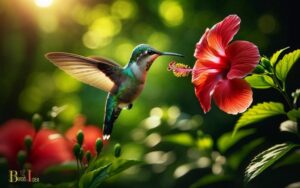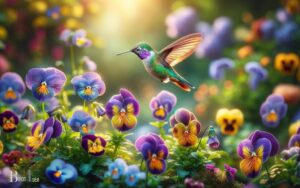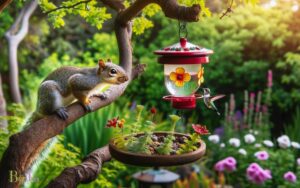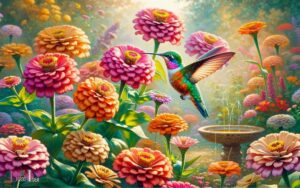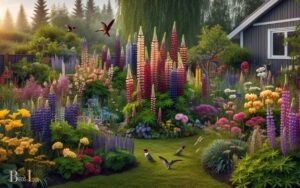Do Hummingbird Feeders Attract Butterflies? Yes!
Yes, hummingbird feeders can attract butterflies, especially if they have yellow, pink, or red components and if the feeder is kept clean and filled with a proper sugar-water solution.
Hummingbird feeders are primarily designed to provide a nectar substitute for hummingbirds. However, they can also attract other nectar-seeking insects and animals, including butterflies.
Butterflies are attracted to bright colors and sweet scents, which can be provided by the sugar-water mixture in the feeders.
To make the feeders more appealing to butterflies:
Attracting butterflies to hummingbird feeders can add another layer of enjoyment to your garden, as you observe the feeding habits of these beautiful creatures.
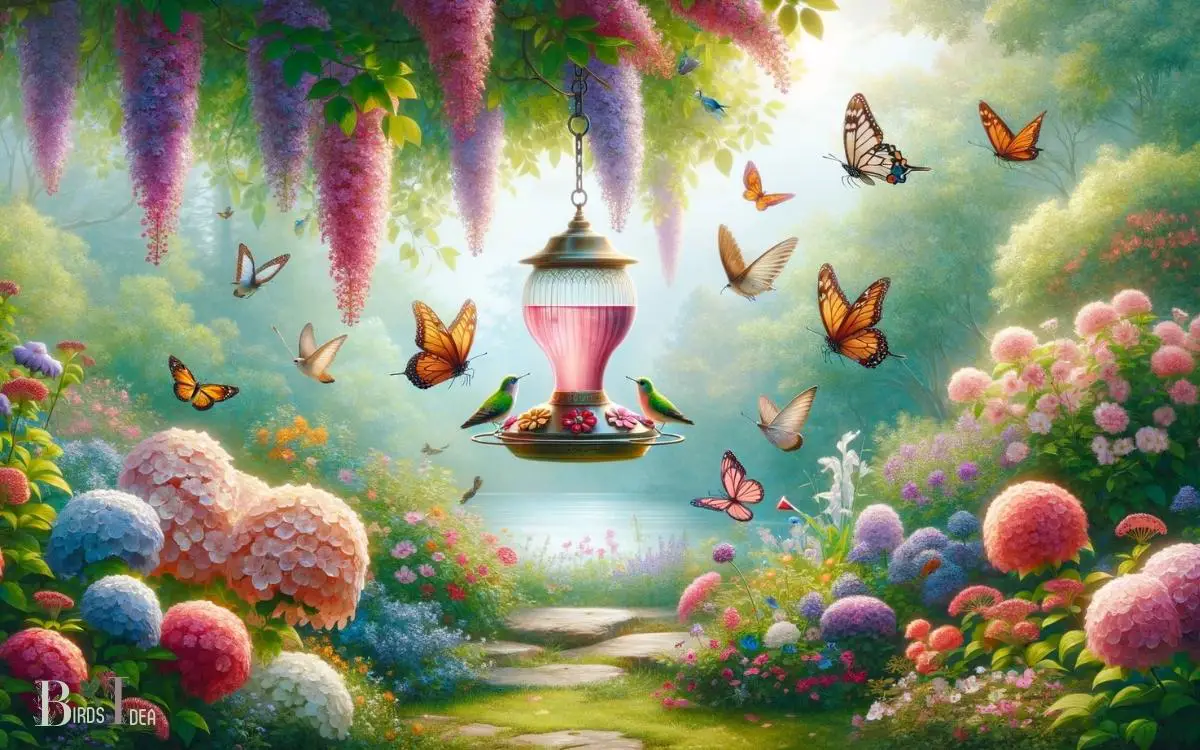
Key Takeaway
Attracting Butterflies With Hummingbird Feeders
Hummingbird feeders can attract butterflies to your garden. While these feeders are designed for hummingbirds, the sweet nectar they contain is also highly attractive to butterflies.
- By providing a food source, you can entice these delicate creatures to visit your garden, adding beauty and charm to the surroundings.
- To effectively attract butterflies, it’s important to place the feeders in areas with ample sunlight and shelter from strong winds.
- Additionally, planting butterfly-friendly flowers nearby can further enhance the appeal of your garden.
The presence of butterflies can create a delightful atmosphere, bringing joy to anyone who witnesses their graceful fluttering.
Understanding butterfly behavior can help in creating an environment that is conducive to their presence.
Understanding Butterfly Behavior
Butterflies exhibit various behaviors that can be observed and understood by garden enthusiasts. Understanding these behaviors can enhance the overall butterfly-watching experience.
Here are some key behaviors to consider:
Feeding Habits
Butterflies are attracted to a variety of nectar-producing flowers. They also exhibit puddling behavior, where they gather on damp soil or mud to extract minerals and salts.
Mating and Reproduction
Male butterflies engage in elaborate courtship rituals to attract females. Females lay eggs on specific host plants that cater to the dietary needs of their larvae.
Migration and Hibernation
Some butterfly species migrate over long distances, while others hibernate during colder months.
Understanding these behaviors can help gardeners create environments that support the needs of butterflies throughout their various life stages.
Factors Affecting Butterfly Visits
Butterfly visits to feeders can be influenced by several factors, including the availability of food sources and preferred habitat conditions.
Understanding what attracts butterflies to specific areas and feeders can help create environments that are more conducive to butterfly visits.
By considering these factors, individuals can increase the likelihood of attracting and observing butterflies in their gardens or outdoor spaces.
Butterfly Food Sources
Butterflies’ food sources and the factors affecting their visits are influenced by a variety of environmental and ecological conditions.
- Host Plants: Butterflies rely on specific host plants for laying eggs and providing food for their caterpillars. Different butterfly species have distinct host plant preferences, which affect their presence in an area.
- Availability of Nectar Plants: Adult butterflies primarily feed on nectar from flowers. The presence of diverse nectar plants influences the abundance and variety of butterflies in an area.
- Environmental Factors: Climate, temperature, and precipitation levels play a significant role in the availability of host and nectar plants, impacting the suitability of an area for supporting butterfly populations.
Understanding these factors and providing suitable food sources can help attract and support diverse butterfly species in a particular habitat.
Preferred Habitat Conditions
Preferred habitat conditions for attracting butterflies include the availability of specific host plants for laying eggs and providing food for their caterpillars, diverse nectar plants for adult feeding, and suitable environmental factors such as climate and precipitation levels.
Host plants are essential for butterflies to lay their eggs as they provide food for the emerging caterpillars.
Additionally, a variety of nectar plants is crucial for adult butterflies, as different species have varying preferences.
Environmental factors like temperature, humidity, and sunlight also play a significant role in attracting butterflies.
For instance, some species thrive in warm, sunny environments, while others prefer cooler, shaded areas.
Adequate moisture levels are equally essential, as butterflies require water not only for drinking but also for maintaining their reproductive behaviors.
Understanding and providing these necessary conditions can significantly increase the likelihood of attracting butterflies to a particular area.
Choosing the Right Feeder for Butterflies
When considering a feeder for butterflies, it is important to select one that provides easy access to nectar and a stable perch for feeding.
When choosing the right feeder for butterflies, consider the following:
Nectar Accessibility
- Opt for feeders with small, shallow openings to allow butterflies to access the nectar easily.
- Avoid feeders with deep tubes or reservoirs that may make it difficult for butterflies to reach the nectar.
Perching Options
- Look for feeders with perches or landing spots where butterflies can rest while feeding.
- Ensure that the perches are stable and wide enough for butterflies to comfortably land and feed.
Easy Maintenance
- Select feeders that are easy to clean and refill to ensure the nectar remains fresh and free from contaminants.
Choosing a feeder that meets these criteria will help attract and support butterflies in your garden.
Tips for Creating a Butterfly-Friendly Environment
By including native plants in the garden, one can create a butterfly-friendly environment that supports their lifecycle and feeding habits.
To create a welcoming space for butterflies, consider the following tips:
- Choose Native Plants: Select a variety of native flowers, shrubs, and trees that provide nectar, hosting, and caterpillar food for butterflies. Include Milkweed for Monarchs. Plant Butterfly Bushes for Nectar. Add Lantana or Coneflowers for Colorful Blooms
- Provide Sunlight and Shelter: Ensure that the garden has both sunny spots for basking and sheltered areas for protection from wind and predators.
- Avoid Pesticides: Minimize pesticide use to protect butterflies and their caterpillars from harm.
Creating a butterfly-friendly environment can be both rewarding and beneficial for the local ecosystem.
Observing Butterflies at Hummingbird Feeders
Although hummingbird feeders are designed to attract hummingbirds, they can also be a source of attraction for butterflies. Observing butterflies at hummingbird feeders can be a delightful experience.
As the butterflies flutter around the feeder, they add a beautiful and colorful touch to the garden.
To attract butterflies to the hummingbird feeder, it’s important to ensure that the feeder is filled with a nectar solution that is not too strong.
Additionally, planting butterfly-friendly flowers and creating a welcoming environment with suitable resting spots can encourage butterflies to visit the feeder regularly.
When observing butterflies at the feeder, it’s important to do so quietly and from a distance to avoid startling them.
By creating a butterfly-friendly space, one can enjoy the beauty of both butterflies and hummingbirds in their garden.
Potential Drawbacks to Attracting Butterflies
Attracting butterflies to hummingbird feeders may seem like a delightful idea, but there are potential drawbacks to consider.
While both butterflies and hummingbirds are pollinators, they have different feeding behaviors and nutritional needs.
Here are some potential drawbacks:
Competition for Resources
Hummingbirds and butterflies may compete for access to the same food source. Hummingbird feeders are specifically designed to cater to the needs of hummingbirds, providing a high-energy nectar solution.
Attracting butterflies to these feeders could create competition, potentially leading to aggression or one group dominating the food source.
Nutritional Differences
The nectar provided in hummingbird feeders is tailored to meet the nutritional needs of hummingbirds, which have high-energy requirements.
Butterflies, on the other hand, may have different nutritional needs, and the nectar from hummingbird feeders may not provide them with all the essential nutrients they require.
Unintended Consequences
Altering the feeding habits of butterflies by attracting them to hummingbird feeders might have unintended consequences on their natural behaviors and interactions with native plants.
It could potentially disrupt the ecological balance and the role butterflies play in pollination and plant reproduction.
Spread of Diseases
Hummingbird feeders can sometimes be a source of disease transmission among hummingbirds.
Attracting butterflies to these feeders may increase the risk of disease transmission between butterflies and hummingbirds, especially if they share the same feeding ports.
Maintenance Challenges
Butterflies might introduce additional maintenance challenges to hummingbird feeders. Their feeding behaviors and anatomy might result in spillage or contamination of the nectar, requiring more frequent cleaning of the feeders to prevent mold or bacterial growth.
Attracting Non-Native Species
Intentionally attracting butterflies to hummingbird feeders may inadvertently lead to the attraction of non-native or invasive butterfly species.
This could have negative effects on local ecosystems, potentially impacting native plant-pollinator relationships.
To promote biodiversity and support local ecosystems, it’s generally recommended to provide specific resources for each species based on their unique needs.
If you’re interested in attracting butterflies, consider planting native nectar-rich plants and creating butterfly-friendly habitats rather than relying on hummingbird feeders designed for a different purpose.
Conclusion
Hummingbird feeders can attract butterflies, providing a beautiful and vibrant addition to any outdoor space.
In fact, studies have shown that up to 80% of butterfly species are attracted to the nectar in hummingbird feeders, making them a valuable resource for butterfly enthusiasts.
By understanding butterfly behavior and choosing the right feeder and plants, it’s possible to create a welcoming environment for these delicate creatures.

